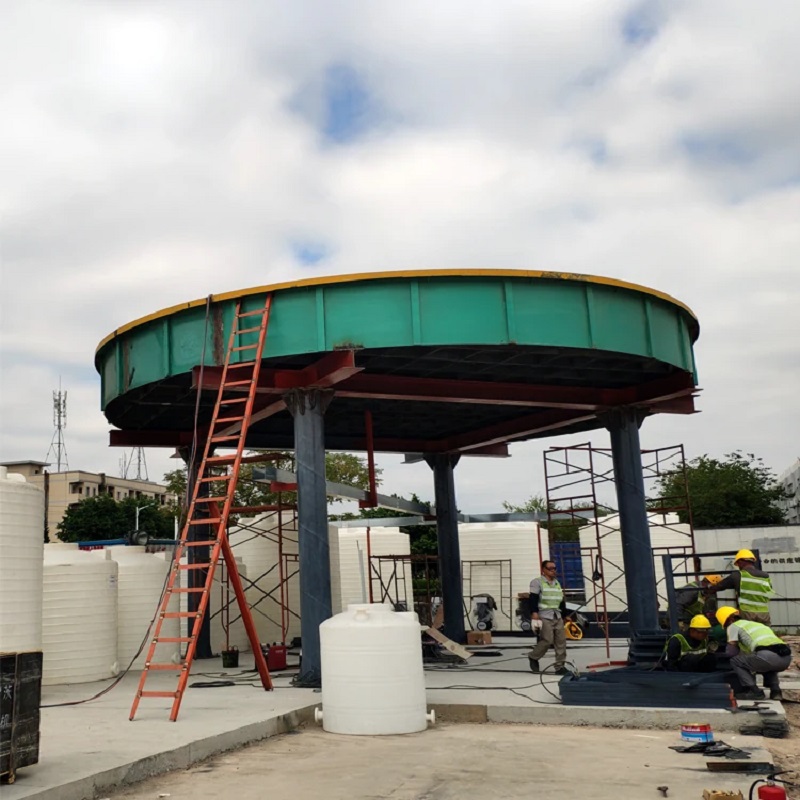
Shallow air flotation machine is an efficient solid-liquid separation equipment designed based on the "shallow pool theory" and "zero velocity principle", widely used in the field of water treatment.
1、 Working principle
Shallow air flotation machines dissolve air in water through a dissolved air system, forming dissolved air water. After the release of dissolved water under reduced pressure, a large number of tiny bubbles (with a diameter of about 3-7 μ m) are generated. These bubbles adhere to suspended solids, oil droplets, and other impurities in the water, forming a float with a density lower than that of water. Under buoyancy, the floating body quickly rises to the surface of the water, forming a layer of floating slag. The floating slag is removed by a scraping device, achieving solid-liquid separation.
2、 Structural characteristics
Cylindrical shallow pool structure: The effective water depth is usually 400-600mm, the floating path is short, the resistance is low, and the processing speed is fast.
Integrated design: integrating functions such as coagulation, air flotation, skimming, sedimentation, and mud scraping, with a compact structure and small footprint.
Rotating water distribution mechanism: By rotating the water distributor, uniform water distribution is achieved, avoiding water flow short circuits and improving treatment efficiency.
Dynamic inlet and outlet system: using dynamic inlet and static outlet methods to control turbulent flow in the tank and achieve smooth solid-liquid separation.
3、 Technical advantages
Efficient and energy-saving:
Short processing time (3-5 minutes) and high processing efficiency.
The gas dissolution efficiency reaches 70% -80%, with high bubble density and strong adsorption capacity.
Small footprint:
The pool body is relatively shallow (400-600mm), so there is no need to build a platform, and the civil engineering cost is low.
It can be elevated, stacked, or installed on buildings to adapt to various installation environments.
Low operating costs:
Microbubbles have a small diameter and high density, which can fully capture small suspended solids and reduce the amount of medication added.
In some cases, it is even possible to operate without medication, reducing operating costs.
Easy to operate:
Fully automated control, convenient operation and management.
The equipment requires minimal maintenance, has a low failure rate, and operates stably.
4、 Application scenarios
Shallow air flotation machines are widely used in the following fields:
Industrial wastewater treatment:
Wastewater treatment in the fields of papermaking, printing and dyeing, textile, electroplating, leather making, food industry, etc.
Recycling useful substances from wastewater, such as fiber recovery from papermaking wastewater.
Municipal sewage treatment:
Pre treatment or advanced treatment of urban sewage plants.
Adapting to the needs of urban sewage plant renovation, modular design, strong flexibility.
Pre treatment of water plant:
The removal of algae and turbidity from water sources such as lakes and reservoirs can improve water quality.
Other fields:
Wastewater treatment in industries such as oil refining, chemical engineering, and pharmaceuticals.
The recovery and resource utilization of useful substances in sewage.
5、 Technical parameters and performance indicators
Processing ability:
Depending on the model, the processing capacity can reach tens to hundreds of cubic meters per hour.
Suitable for the treatment of high concentration wastewater (influent SS ≤ 6000mg/L).
Outlet water quality:
The effluent SS is ≤ 30mg/L, and the COD removal rate can reach 45% -73%.
BOD5 removal rate is 60% -80%, and chromaticity removal is about 80% -90%.
Equipment material:
There are three types: carbon steel (key stainless steel), partial stainless steel, and full stainless steel.
Carbon steel equipment has undergone special anti-corrosion treatment, which is resistant to acid and alkali corrosion and has a long service life.
6、 Comparison with other air flotation equipment
Comparison with traditional dissolved air flotation machine:
Traditional dissolved air flotation machines have low treatment capacity, long sewage retention time (40-60 minutes), large equipment volume, and low purification rate.
Shallow air flotation machine has a short processing time (3-5 minutes), small equipment volume, and high purification rate (SS removal rate of over 90%).
Comparison with vortex concave air flotation machine and laminar air flotation machine:
Shallow air flotation machines have a more compact structure and higher treatment efficiency, making them suitable for the treatment of high concentration wastewater.
Vortex concave air flotation machine and laminar air flotation machine have certain advantages in treating low concentration sewage, but shallow air flotation machine has better comprehensive performance.
7、 Summary
Shallow air flotation machine, as an efficient solid-liquid separation equipment, has been widely used in the field of water treatment due to its advantages of high efficiency, energy saving, small footprint, and low operating costs. Its integrated design, dynamic inlet and outlet water system, and microbubble technology make it perform excellently in treating high concentration wastewater and recovering useful substances. With the continuous development of technology, shallow air flotation machines will play a more important role in the field of water treatment.